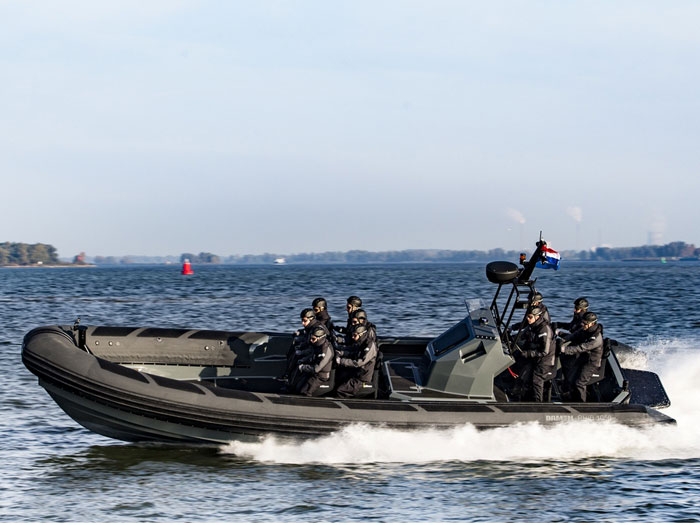
Damen unveils next generation RHIB
Written by Nick Blenkey
The RHIB 1050 was developed at Damen Shipyards Hardinxveld, a long time RHIB supplier to the Royal Netherlands Navy.
"This is not your average RHIB," says Roel Foolen, the shipyard's Newbuild Project Manager. "For starters, it's Lloyds approved. The hull is made of glass reinforced epoxy as opposed to polyester and provided with Lloyd's approved closed cell, foam core."
"Further to this, we are also able to provide training in its use," adds Mr. Foolen. "Damen has many years' experience in building boats for navies and other defence and security bodies."
Damen's use of epoxy for the hull will see the RHIB 1050 produced at the group's specialist composites yard in Antalya, Turkey.
The RHIB will be produced in series with a standard hull, open to flexible, client-specified outfitting requirements.
Ergonomics are a strong theme running throughout the design. Damen developed the layout using a mock-up console, constantly tweaking the positioning of instrumentation, seating and controls until completely satisfied with comfort levels. Consequently, the wheel and throttle are perfectly aligned with the suspension seating and handles and grips are located strategically throughout the RHIB.
"We've aimed to cover every detail – for example including steps to facilitate easy, fast exit of the RHIB in boarding ops and integration of hoisting eyes into the bollards, simultaneously removing a trip hazard and taking advantage of every available bit of space," says Mr. Foolen.
The RHIB uses D-shaped tubing, rather than the conventional cylindrical tubing.
"Doing this allows us to combine the console and the engines into a single, space saving unit," says Mr. Foolen." Usually this would not be possible as such a unit would impede access to the fore of the vessel. However, with a section of tubing removed, there is still space for on board personnel to pass safely and comfortably fore to aft."
The vessel is easy to maintain. For example, its two 350 liter fuel tanks are located beneath the ten deck-based seats which are fitted to a dedicated hatch so that, in the event the tanks require removing, the seating is simply lifted clear.
Similarly, the entire console unit is hinged at the aft so that it can be very easily moved clear when access is necessary to the RHIB's two 370 hp Volvo Penta engines. The mast is also hinged so that it can be quickly folded away for transport height.
"As well as easy maintenance, the RHIB 1050 is also low maintenance," says Mr Foolen. "We've used high-end materials and taken every step to ensure components are protected. Console instrumentation is located behind a heated, watertight window for example. And all electrics are housed in a dedicated, heated and ventilated compartment inside the dry storage area."
The stern platform, as well as being ideally situated for diving and man overboard operations, works in combination with the tube ends to form a protective barrier for the stern drives.
At the front of the vessel, the nose is flattened to serve as a fender during boarding operations and the tubing is fitted to the vessel with aluminum extrusions, not glue. This not only offers a better grip, but also makes it easier to remove and replace when necessary.
How about performance?
"During seatrials, the handling, maneuverability and balance have proven to be excellent," says Mr. Foolen. "It's very safe also, very forgiving and perfect in rough, harsh water. She's quick too – able to sail at speeds of over 50 knots."
Damen is currently building a second RHIB 1050, which will feature two 400 hp outboard engines.
DECEMBER 10, 2015 — Damen Shipyards Group’s new RHIB 1050 represents the next generation in rigid hull inflatable boats.The 10.5 m x 3.35 m multi-mission vessel that can serve as an independent platform or as support for a larger patrol vessel.





Leave a Reply
You must be logged in to post a comment.